Investigating Criminal Behaviour: Psychological Theories & Trauma
VerifiedAdded on 2023/06/14
|13
|3852
|286
Report
AI Summary
This report delves into the psychology of behaviour, focusing on psychological perspectives and their influence on criminal behaviour. It investigates various theories, including social psychological, sociological, and biological theories, to understand the origins of criminal actions. The report also explores the impact of trauma on behaviour, highlighting the correlation between childhood trauma and later criminal activity. Furthermore, it discusses trauma-informed practices implemented within the UK justice system, emphasizing strength-based approaches to address the impact of trauma on individuals' lives. The report concludes by summarizing key findings and underscoring the importance of understanding psychological factors in addressing criminal behaviour. Desklib provides a platform for students to access this and other solved assignments.

Psychology of Behaviour.
Paraphrase This Document
Need a fresh take? Get an instant paraphrase of this document with our AI Paraphraser
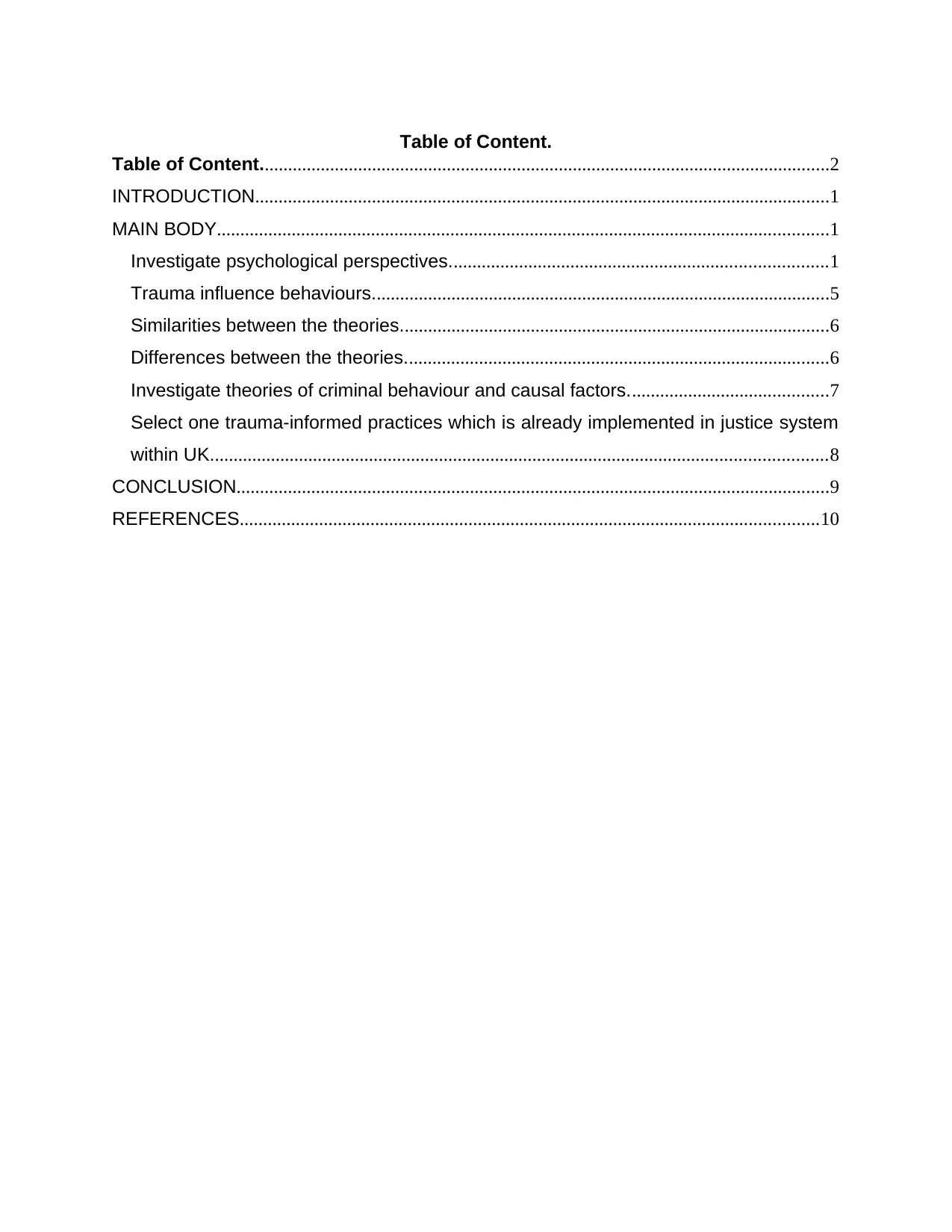
Table of Content.
Table of Content..........................................................................................................................2
INTRODUCTION...........................................................................................................................1
MAIN BODY...................................................................................................................................1
Investigate psychological perspectives.................................................................................1
Trauma influence behaviours..................................................................................................5
Similarities between the theories............................................................................................6
Differences between the theories...........................................................................................6
Investigate theories of criminal behaviour and causal factors...........................................7
Select one trauma-informed practices which is already implemented in justice system
within UK....................................................................................................................................8
CONCLUSION...............................................................................................................................9
REFERENCES............................................................................................................................10
Table of Content..........................................................................................................................2
INTRODUCTION...........................................................................................................................1
MAIN BODY...................................................................................................................................1
Investigate psychological perspectives.................................................................................1
Trauma influence behaviours..................................................................................................5
Similarities between the theories............................................................................................6
Differences between the theories...........................................................................................6
Investigate theories of criminal behaviour and causal factors...........................................7
Select one trauma-informed practices which is already implemented in justice system
within UK....................................................................................................................................8
CONCLUSION...............................................................................................................................9
REFERENCES............................................................................................................................10
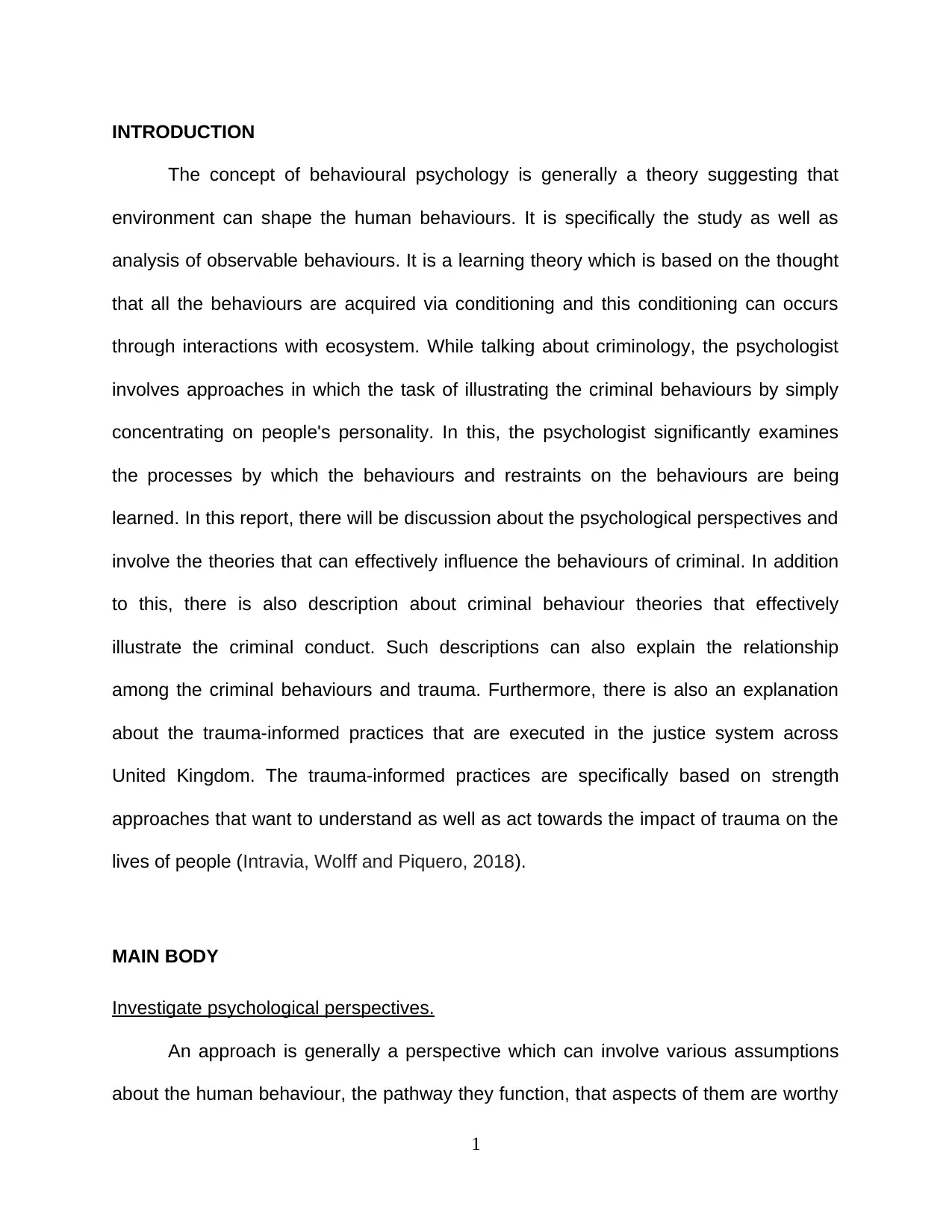
INTRODUCTION
The concept of behavioural psychology is generally a theory suggesting that
environment can shape the human behaviours. It is specifically the study as well as
analysis of observable behaviours. It is a learning theory which is based on the thought
that all the behaviours are acquired via conditioning and this conditioning can occurs
through interactions with ecosystem. While talking about criminology, the psychologist
involves approaches in which the task of illustrating the criminal behaviours by simply
concentrating on people's personality. In this, the psychologist significantly examines
the processes by which the behaviours and restraints on the behaviours are being
learned. In this report, there will be discussion about the psychological perspectives and
involve the theories that can effectively influence the behaviours of criminal. In addition
to this, there is also description about criminal behaviour theories that effectively
illustrate the criminal conduct. Such descriptions can also explain the relationship
among the criminal behaviours and trauma. Furthermore, there is also an explanation
about the trauma-informed practices that are executed in the justice system across
United Kingdom. The trauma-informed practices are specifically based on strength
approaches that want to understand as well as act towards the impact of trauma on the
lives of people (Intravia, Wolff and Piquero, 2018).
MAIN BODY
Investigate psychological perspectives.
An approach is generally a perspective which can involve various assumptions
about the human behaviour, the pathway they function, that aspects of them are worthy
1
The concept of behavioural psychology is generally a theory suggesting that
environment can shape the human behaviours. It is specifically the study as well as
analysis of observable behaviours. It is a learning theory which is based on the thought
that all the behaviours are acquired via conditioning and this conditioning can occurs
through interactions with ecosystem. While talking about criminology, the psychologist
involves approaches in which the task of illustrating the criminal behaviours by simply
concentrating on people's personality. In this, the psychologist significantly examines
the processes by which the behaviours and restraints on the behaviours are being
learned. In this report, there will be discussion about the psychological perspectives and
involve the theories that can effectively influence the behaviours of criminal. In addition
to this, there is also description about criminal behaviour theories that effectively
illustrate the criminal conduct. Such descriptions can also explain the relationship
among the criminal behaviours and trauma. Furthermore, there is also an explanation
about the trauma-informed practices that are executed in the justice system across
United Kingdom. The trauma-informed practices are specifically based on strength
approaches that want to understand as well as act towards the impact of trauma on the
lives of people (Intravia, Wolff and Piquero, 2018).
MAIN BODY
Investigate psychological perspectives.
An approach is generally a perspective which can involve various assumptions
about the human behaviour, the pathway they function, that aspects of them are worthy
1
⊘ This is a preview!⊘
Do you want full access?
Subscribe today to unlock all pages.

Trusted by 1+ million students worldwide
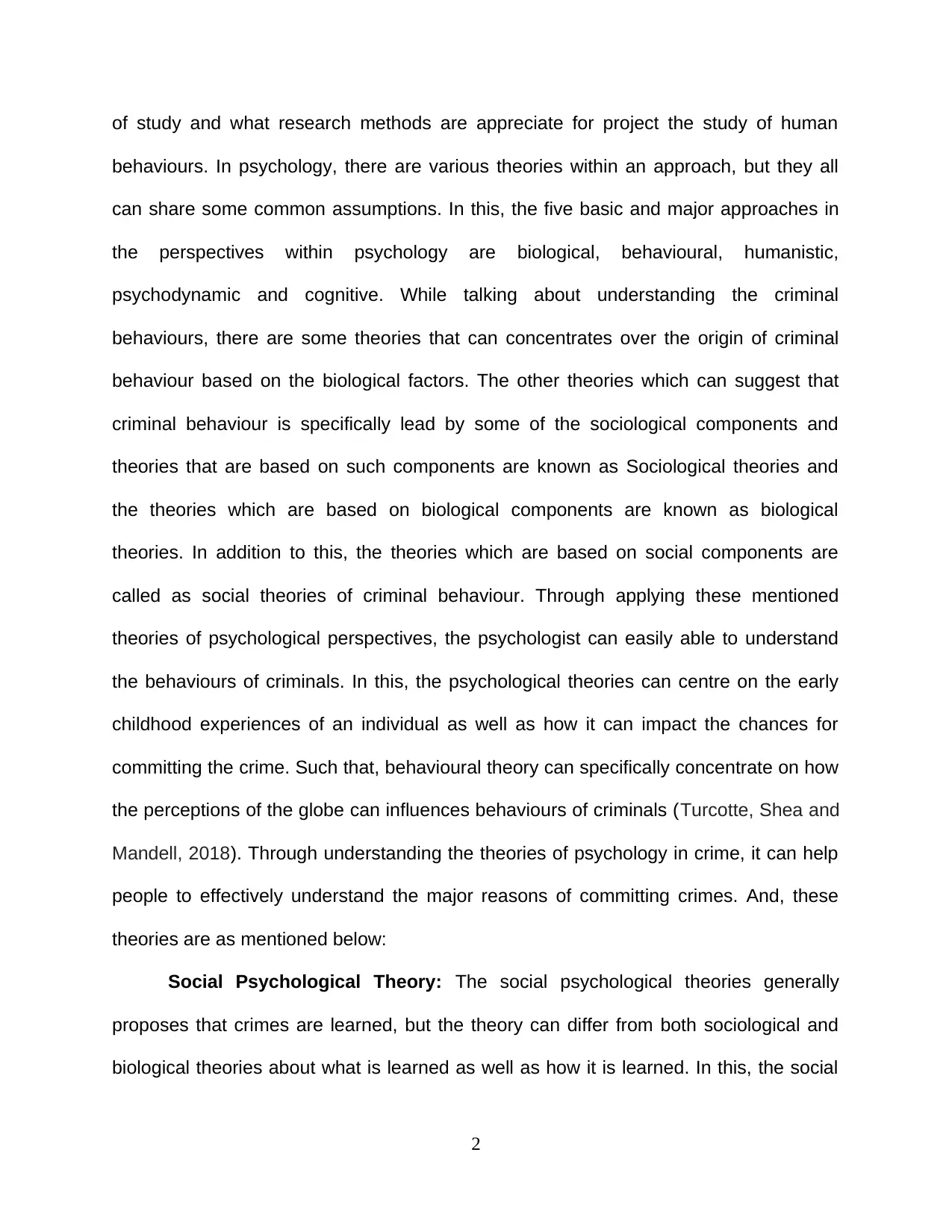
of study and what research methods are appreciate for project the study of human
behaviours. In psychology, there are various theories within an approach, but they all
can share some common assumptions. In this, the five basic and major approaches in
the perspectives within psychology are biological, behavioural, humanistic,
psychodynamic and cognitive. While talking about understanding the criminal
behaviours, there are some theories that can concentrates over the origin of criminal
behaviour based on the biological factors. The other theories which can suggest that
criminal behaviour is specifically lead by some of the sociological components and
theories that are based on such components are known as Sociological theories and
the theories which are based on biological components are known as biological
theories. In addition to this, the theories which are based on social components are
called as social theories of criminal behaviour. Through applying these mentioned
theories of psychological perspectives, the psychologist can easily able to understand
the behaviours of criminals. In this, the psychological theories can centre on the early
childhood experiences of an individual as well as how it can impact the chances for
committing the crime. Such that, behavioural theory can specifically concentrate on how
the perceptions of the globe can influences behaviours of criminals (Turcotte, Shea and
Mandell, 2018). Through understanding the theories of psychology in crime, it can help
people to effectively understand the major reasons of committing crimes. And, these
theories are as mentioned below:
Social Psychological Theory: The social psychological theories generally
proposes that crimes are learned, but the theory can differ from both sociological and
biological theories about what is learned as well as how it is learned. In this, the social
2
behaviours. In psychology, there are various theories within an approach, but they all
can share some common assumptions. In this, the five basic and major approaches in
the perspectives within psychology are biological, behavioural, humanistic,
psychodynamic and cognitive. While talking about understanding the criminal
behaviours, there are some theories that can concentrates over the origin of criminal
behaviour based on the biological factors. The other theories which can suggest that
criminal behaviour is specifically lead by some of the sociological components and
theories that are based on such components are known as Sociological theories and
the theories which are based on biological components are known as biological
theories. In addition to this, the theories which are based on social components are
called as social theories of criminal behaviour. Through applying these mentioned
theories of psychological perspectives, the psychologist can easily able to understand
the behaviours of criminals. In this, the psychological theories can centre on the early
childhood experiences of an individual as well as how it can impact the chances for
committing the crime. Such that, behavioural theory can specifically concentrate on how
the perceptions of the globe can influences behaviours of criminals (Turcotte, Shea and
Mandell, 2018). Through understanding the theories of psychology in crime, it can help
people to effectively understand the major reasons of committing crimes. And, these
theories are as mentioned below:
Social Psychological Theory: The social psychological theories generally
proposes that crimes are learned, but the theory can differ from both sociological and
biological theories about what is learned as well as how it is learned. In this, the social
2
Paraphrase This Document
Need a fresh take? Get an instant paraphrase of this document with our AI Paraphraser
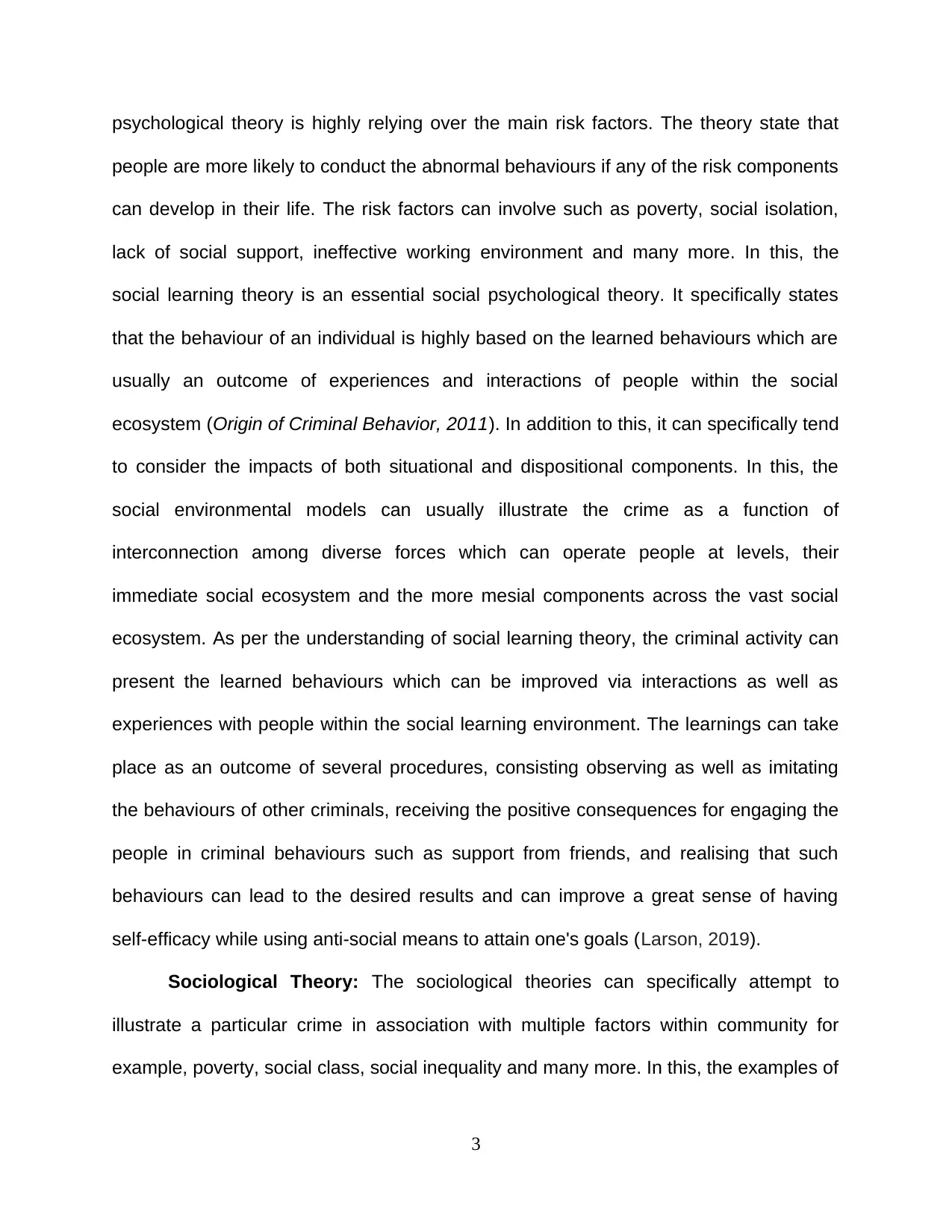
psychological theory is highly relying over the main risk factors. The theory state that
people are more likely to conduct the abnormal behaviours if any of the risk components
can develop in their life. The risk factors can involve such as poverty, social isolation,
lack of social support, ineffective working environment and many more. In this, the
social learning theory is an essential social psychological theory. It specifically states
that the behaviour of an individual is highly based on the learned behaviours which are
usually an outcome of experiences and interactions of people within the social
ecosystem (Origin of Criminal Behavior, 2011). In addition to this, it can specifically tend
to consider the impacts of both situational and dispositional components. In this, the
social environmental models can usually illustrate the crime as a function of
interconnection among diverse forces which can operate people at levels, their
immediate social ecosystem and the more mesial components across the vast social
ecosystem. As per the understanding of social learning theory, the criminal activity can
present the learned behaviours which can be improved via interactions as well as
experiences with people within the social learning environment. The learnings can take
place as an outcome of several procedures, consisting observing as well as imitating
the behaviours of other criminals, receiving the positive consequences for engaging the
people in criminal behaviours such as support from friends, and realising that such
behaviours can lead to the desired results and can improve a great sense of having
self-efficacy while using anti-social means to attain one's goals (Larson, 2019).
Sociological Theory: The sociological theories can specifically attempt to
illustrate a particular crime in association with multiple factors within community for
example, poverty, social class, social inequality and many more. In this, the examples of
3
people are more likely to conduct the abnormal behaviours if any of the risk components
can develop in their life. The risk factors can involve such as poverty, social isolation,
lack of social support, ineffective working environment and many more. In this, the
social learning theory is an essential social psychological theory. It specifically states
that the behaviour of an individual is highly based on the learned behaviours which are
usually an outcome of experiences and interactions of people within the social
ecosystem (Origin of Criminal Behavior, 2011). In addition to this, it can specifically tend
to consider the impacts of both situational and dispositional components. In this, the
social environmental models can usually illustrate the crime as a function of
interconnection among diverse forces which can operate people at levels, their
immediate social ecosystem and the more mesial components across the vast social
ecosystem. As per the understanding of social learning theory, the criminal activity can
present the learned behaviours which can be improved via interactions as well as
experiences with people within the social learning environment. The learnings can take
place as an outcome of several procedures, consisting observing as well as imitating
the behaviours of other criminals, receiving the positive consequences for engaging the
people in criminal behaviours such as support from friends, and realising that such
behaviours can lead to the desired results and can improve a great sense of having
self-efficacy while using anti-social means to attain one's goals (Larson, 2019).
Sociological Theory: The sociological theories can specifically attempt to
illustrate a particular crime in association with multiple factors within community for
example, poverty, social class, social inequality and many more. In this, the examples of
3
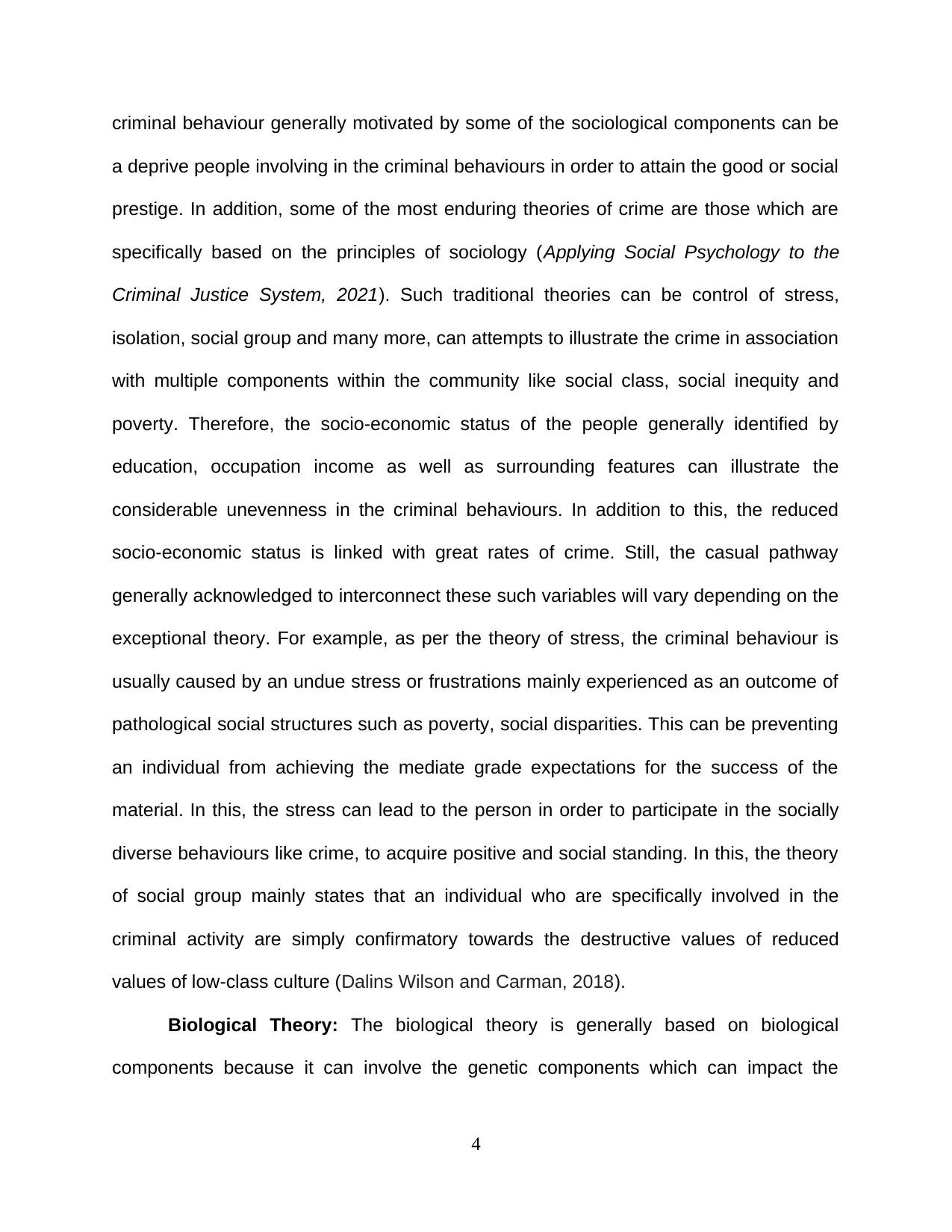
criminal behaviour generally motivated by some of the sociological components can be
a deprive people involving in the criminal behaviours in order to attain the good or social
prestige. In addition, some of the most enduring theories of crime are those which are
specifically based on the principles of sociology (Applying Social Psychology to the
Criminal Justice System, 2021). Such traditional theories can be control of stress,
isolation, social group and many more, can attempts to illustrate the crime in association
with multiple components within the community like social class, social inequity and
poverty. Therefore, the socio-economic status of the people generally identified by
education, occupation income as well as surrounding features can illustrate the
considerable unevenness in the criminal behaviours. In addition to this, the reduced
socio-economic status is linked with great rates of crime. Still, the casual pathway
generally acknowledged to interconnect these such variables will vary depending on the
exceptional theory. For example, as per the theory of stress, the criminal behaviour is
usually caused by an undue stress or frustrations mainly experienced as an outcome of
pathological social structures such as poverty, social disparities. This can be preventing
an individual from achieving the mediate grade expectations for the success of the
material. In this, the stress can lead to the person in order to participate in the socially
diverse behaviours like crime, to acquire positive and social standing. In this, the theory
of social group mainly states that an individual who are specifically involved in the
criminal activity are simply confirmatory towards the destructive values of reduced
values of low-class culture (Dalins Wilson and Carman, 2018).
Biological Theory: The biological theory is generally based on biological
components because it can involve the genetic components which can impact the
4
a deprive people involving in the criminal behaviours in order to attain the good or social
prestige. In addition, some of the most enduring theories of crime are those which are
specifically based on the principles of sociology (Applying Social Psychology to the
Criminal Justice System, 2021). Such traditional theories can be control of stress,
isolation, social group and many more, can attempts to illustrate the crime in association
with multiple components within the community like social class, social inequity and
poverty. Therefore, the socio-economic status of the people generally identified by
education, occupation income as well as surrounding features can illustrate the
considerable unevenness in the criminal behaviours. In addition to this, the reduced
socio-economic status is linked with great rates of crime. Still, the casual pathway
generally acknowledged to interconnect these such variables will vary depending on the
exceptional theory. For example, as per the theory of stress, the criminal behaviour is
usually caused by an undue stress or frustrations mainly experienced as an outcome of
pathological social structures such as poverty, social disparities. This can be preventing
an individual from achieving the mediate grade expectations for the success of the
material. In this, the stress can lead to the person in order to participate in the socially
diverse behaviours like crime, to acquire positive and social standing. In this, the theory
of social group mainly states that an individual who are specifically involved in the
criminal activity are simply confirmatory towards the destructive values of reduced
values of low-class culture (Dalins Wilson and Carman, 2018).
Biological Theory: The biological theory is generally based on biological
components because it can involve the genetic components which can impact the
4
⊘ This is a preview!⊘
Do you want full access?
Subscribe today to unlock all pages.

Trusted by 1+ million students worldwide
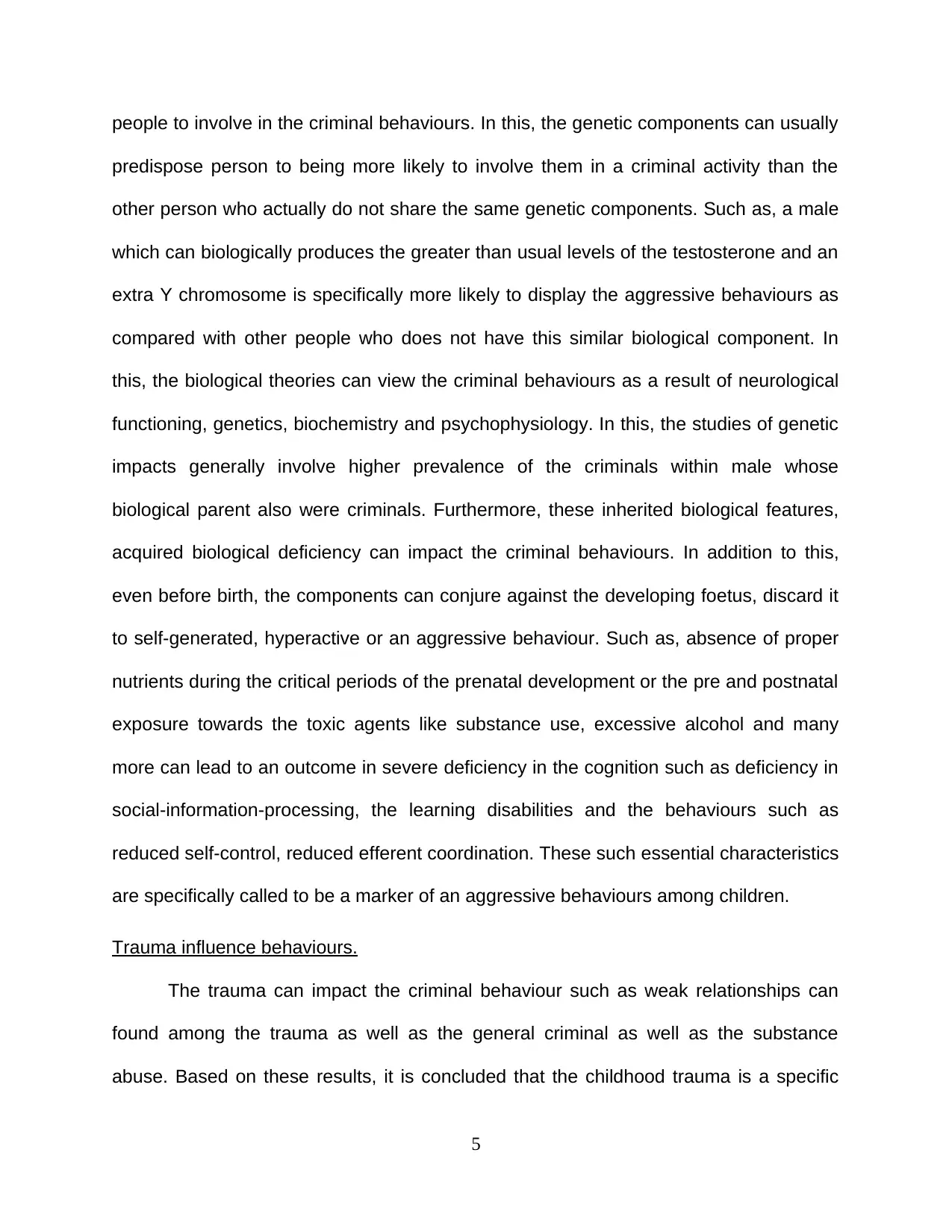
people to involve in the criminal behaviours. In this, the genetic components can usually
predispose person to being more likely to involve them in a criminal activity than the
other person who actually do not share the same genetic components. Such as, a male
which can biologically produces the greater than usual levels of the testosterone and an
extra Y chromosome is specifically more likely to display the aggressive behaviours as
compared with other people who does not have this similar biological component. In
this, the biological theories can view the criminal behaviours as a result of neurological
functioning, genetics, biochemistry and psychophysiology. In this, the studies of genetic
impacts generally involve higher prevalence of the criminals within male whose
biological parent also were criminals. Furthermore, these inherited biological features,
acquired biological deficiency can impact the criminal behaviours. In addition to this,
even before birth, the components can conjure against the developing foetus, discard it
to self-generated, hyperactive or an aggressive behaviour. Such as, absence of proper
nutrients during the critical periods of the prenatal development or the pre and postnatal
exposure towards the toxic agents like substance use, excessive alcohol and many
more can lead to an outcome in severe deficiency in the cognition such as deficiency in
social-information-processing, the learning disabilities and the behaviours such as
reduced self-control, reduced efferent coordination. These such essential characteristics
are specifically called to be a marker of an aggressive behaviours among children.
Trauma influence behaviours.
The trauma can impact the criminal behaviour such as weak relationships can
found among the trauma as well as the general criminal as well as the substance
abuse. Based on these results, it is concluded that the childhood trauma is a specific
5
predispose person to being more likely to involve them in a criminal activity than the
other person who actually do not share the same genetic components. Such as, a male
which can biologically produces the greater than usual levels of the testosterone and an
extra Y chromosome is specifically more likely to display the aggressive behaviours as
compared with other people who does not have this similar biological component. In
this, the biological theories can view the criminal behaviours as a result of neurological
functioning, genetics, biochemistry and psychophysiology. In this, the studies of genetic
impacts generally involve higher prevalence of the criminals within male whose
biological parent also were criminals. Furthermore, these inherited biological features,
acquired biological deficiency can impact the criminal behaviours. In addition to this,
even before birth, the components can conjure against the developing foetus, discard it
to self-generated, hyperactive or an aggressive behaviour. Such as, absence of proper
nutrients during the critical periods of the prenatal development or the pre and postnatal
exposure towards the toxic agents like substance use, excessive alcohol and many
more can lead to an outcome in severe deficiency in the cognition such as deficiency in
social-information-processing, the learning disabilities and the behaviours such as
reduced self-control, reduced efferent coordination. These such essential characteristics
are specifically called to be a marker of an aggressive behaviours among children.
Trauma influence behaviours.
The trauma can impact the criminal behaviour such as weak relationships can
found among the trauma as well as the general criminal as well as the substance
abuse. Based on these results, it is concluded that the childhood trauma is a specific
5
Paraphrase This Document
Need a fresh take? Get an instant paraphrase of this document with our AI Paraphraser
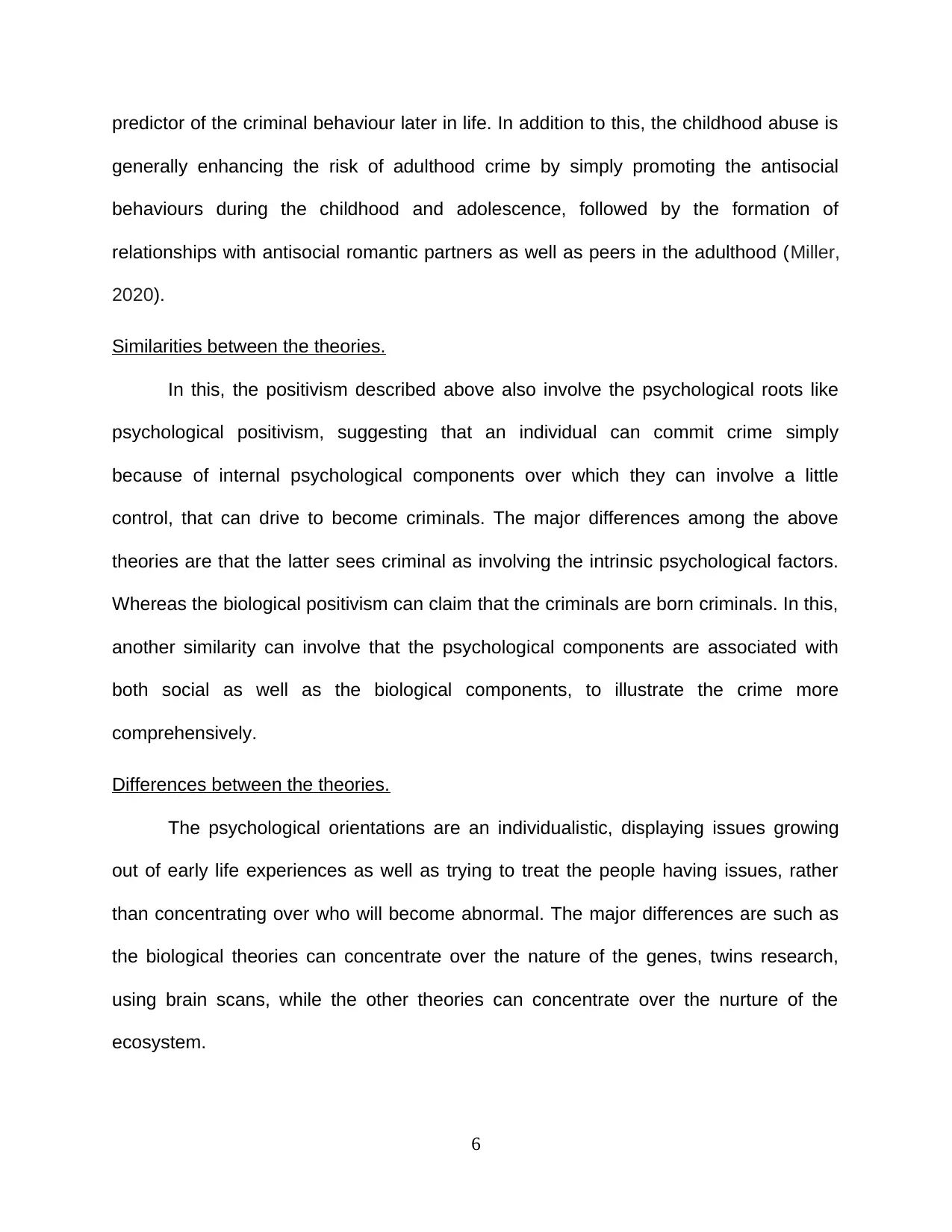
predictor of the criminal behaviour later in life. In addition to this, the childhood abuse is
generally enhancing the risk of adulthood crime by simply promoting the antisocial
behaviours during the childhood and adolescence, followed by the formation of
relationships with antisocial romantic partners as well as peers in the adulthood (Miller,
2020).
Similarities between the theories.
In this, the positivism described above also involve the psychological roots like
psychological positivism, suggesting that an individual can commit crime simply
because of internal psychological components over which they can involve a little
control, that can drive to become criminals. The major differences among the above
theories are that the latter sees criminal as involving the intrinsic psychological factors.
Whereas the biological positivism can claim that the criminals are born criminals. In this,
another similarity can involve that the psychological components are associated with
both social as well as the biological components, to illustrate the crime more
comprehensively.
Differences between the theories.
The psychological orientations are an individualistic, displaying issues growing
out of early life experiences as well as trying to treat the people having issues, rather
than concentrating over who will become abnormal. The major differences are such as
the biological theories can concentrate over the nature of the genes, twins research,
using brain scans, while the other theories can concentrate over the nurture of the
ecosystem.
6
generally enhancing the risk of adulthood crime by simply promoting the antisocial
behaviours during the childhood and adolescence, followed by the formation of
relationships with antisocial romantic partners as well as peers in the adulthood (Miller,
2020).
Similarities between the theories.
In this, the positivism described above also involve the psychological roots like
psychological positivism, suggesting that an individual can commit crime simply
because of internal psychological components over which they can involve a little
control, that can drive to become criminals. The major differences among the above
theories are that the latter sees criminal as involving the intrinsic psychological factors.
Whereas the biological positivism can claim that the criminals are born criminals. In this,
another similarity can involve that the psychological components are associated with
both social as well as the biological components, to illustrate the crime more
comprehensively.
Differences between the theories.
The psychological orientations are an individualistic, displaying issues growing
out of early life experiences as well as trying to treat the people having issues, rather
than concentrating over who will become abnormal. The major differences are such as
the biological theories can concentrate over the nature of the genes, twins research,
using brain scans, while the other theories can concentrate over the nurture of the
ecosystem.
6
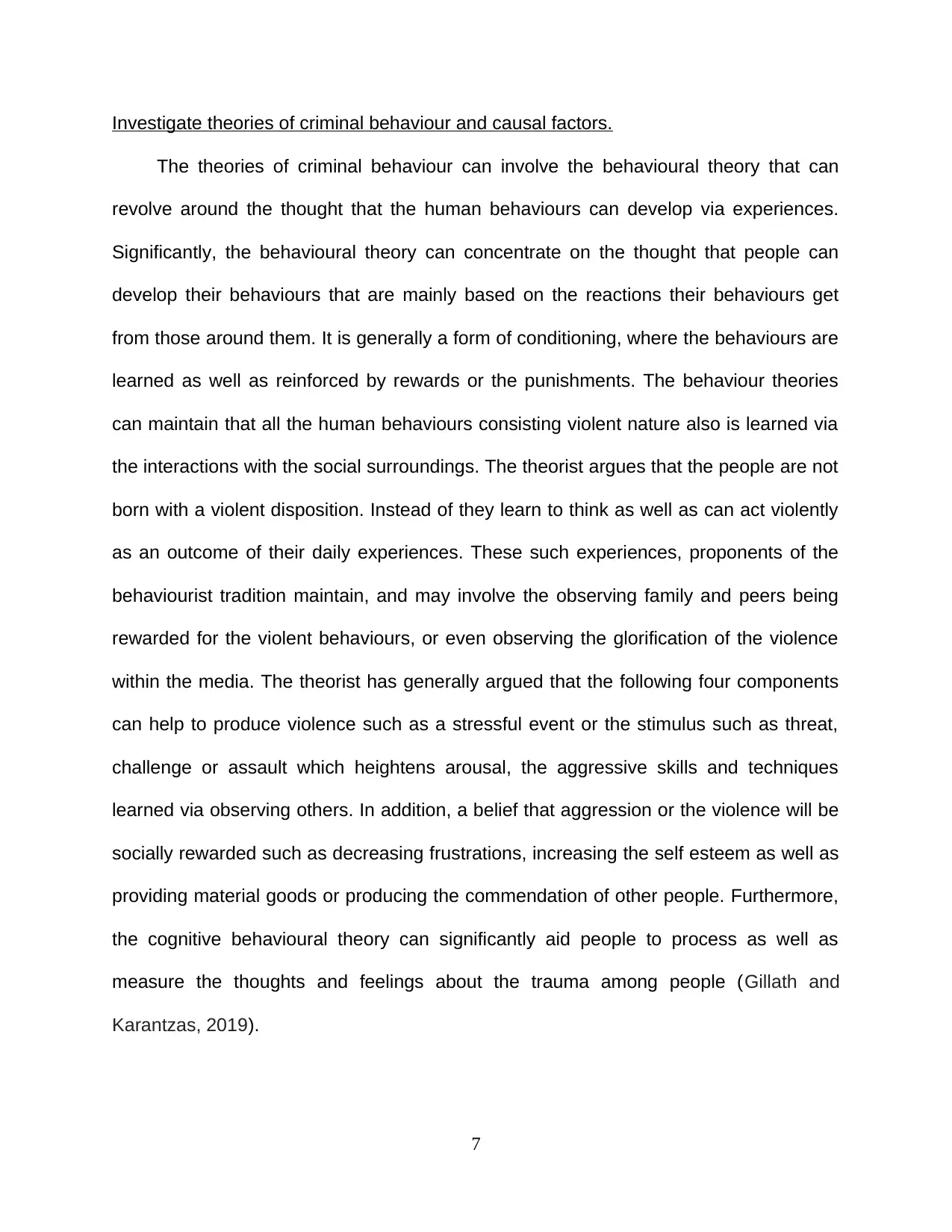
Investigate theories of criminal behaviour and causal factors.
The theories of criminal behaviour can involve the behavioural theory that can
revolve around the thought that the human behaviours can develop via experiences.
Significantly, the behavioural theory can concentrate on the thought that people can
develop their behaviours that are mainly based on the reactions their behaviours get
from those around them. It is generally a form of conditioning, where the behaviours are
learned as well as reinforced by rewards or the punishments. The behaviour theories
can maintain that all the human behaviours consisting violent nature also is learned via
the interactions with the social surroundings. The theorist argues that the people are not
born with a violent disposition. Instead of they learn to think as well as can act violently
as an outcome of their daily experiences. These such experiences, proponents of the
behaviourist tradition maintain, and may involve the observing family and peers being
rewarded for the violent behaviours, or even observing the glorification of the violence
within the media. The theorist has generally argued that the following four components
can help to produce violence such as a stressful event or the stimulus such as threat,
challenge or assault which heightens arousal, the aggressive skills and techniques
learned via observing others. In addition, a belief that aggression or the violence will be
socially rewarded such as decreasing frustrations, increasing the self esteem as well as
providing material goods or producing the commendation of other people. Furthermore,
the cognitive behavioural theory can significantly aid people to process as well as
measure the thoughts and feelings about the trauma among people (Gillath and
Karantzas, 2019).
7
The theories of criminal behaviour can involve the behavioural theory that can
revolve around the thought that the human behaviours can develop via experiences.
Significantly, the behavioural theory can concentrate on the thought that people can
develop their behaviours that are mainly based on the reactions their behaviours get
from those around them. It is generally a form of conditioning, where the behaviours are
learned as well as reinforced by rewards or the punishments. The behaviour theories
can maintain that all the human behaviours consisting violent nature also is learned via
the interactions with the social surroundings. The theorist argues that the people are not
born with a violent disposition. Instead of they learn to think as well as can act violently
as an outcome of their daily experiences. These such experiences, proponents of the
behaviourist tradition maintain, and may involve the observing family and peers being
rewarded for the violent behaviours, or even observing the glorification of the violence
within the media. The theorist has generally argued that the following four components
can help to produce violence such as a stressful event or the stimulus such as threat,
challenge or assault which heightens arousal, the aggressive skills and techniques
learned via observing others. In addition, a belief that aggression or the violence will be
socially rewarded such as decreasing frustrations, increasing the self esteem as well as
providing material goods or producing the commendation of other people. Furthermore,
the cognitive behavioural theory can significantly aid people to process as well as
measure the thoughts and feelings about the trauma among people (Gillath and
Karantzas, 2019).
7
⊘ This is a preview!⊘
Do you want full access?
Subscribe today to unlock all pages.

Trusted by 1+ million students worldwide
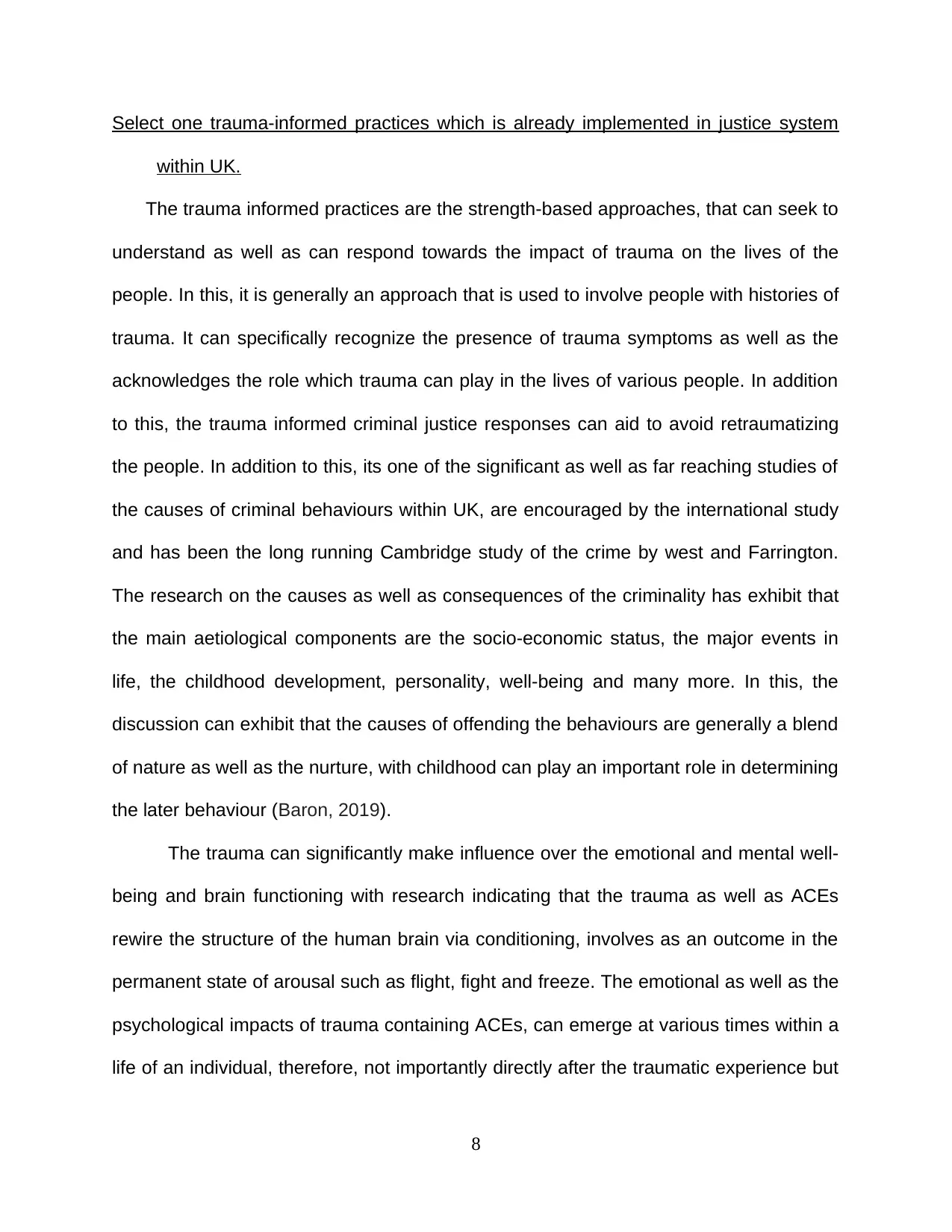
Select one trauma-informed practices which is already implemented in justice system
within UK.
The trauma informed practices are the strength-based approaches, that can seek to
understand as well as can respond towards the impact of trauma on the lives of the
people. In this, it is generally an approach that is used to involve people with histories of
trauma. It can specifically recognize the presence of trauma symptoms as well as the
acknowledges the role which trauma can play in the lives of various people. In addition
to this, the trauma informed criminal justice responses can aid to avoid retraumatizing
the people. In addition to this, its one of the significant as well as far reaching studies of
the causes of criminal behaviours within UK, are encouraged by the international study
and has been the long running Cambridge study of the crime by west and Farrington.
The research on the causes as well as consequences of the criminality has exhibit that
the main aetiological components are the socio-economic status, the major events in
life, the childhood development, personality, well-being and many more. In this, the
discussion can exhibit that the causes of offending the behaviours are generally a blend
of nature as well as the nurture, with childhood can play an important role in determining
the later behaviour (Baron, 2019).
The trauma can significantly make influence over the emotional and mental well-
being and brain functioning with research indicating that the trauma as well as ACEs
rewire the structure of the human brain via conditioning, involves as an outcome in the
permanent state of arousal such as flight, fight and freeze. The emotional as well as the
psychological impacts of trauma containing ACEs, can emerge at various times within a
life of an individual, therefore, not importantly directly after the traumatic experience but
8
within UK.
The trauma informed practices are the strength-based approaches, that can seek to
understand as well as can respond towards the impact of trauma on the lives of the
people. In this, it is generally an approach that is used to involve people with histories of
trauma. It can specifically recognize the presence of trauma symptoms as well as the
acknowledges the role which trauma can play in the lives of various people. In addition
to this, the trauma informed criminal justice responses can aid to avoid retraumatizing
the people. In addition to this, its one of the significant as well as far reaching studies of
the causes of criminal behaviours within UK, are encouraged by the international study
and has been the long running Cambridge study of the crime by west and Farrington.
The research on the causes as well as consequences of the criminality has exhibit that
the main aetiological components are the socio-economic status, the major events in
life, the childhood development, personality, well-being and many more. In this, the
discussion can exhibit that the causes of offending the behaviours are generally a blend
of nature as well as the nurture, with childhood can play an important role in determining
the later behaviour (Baron, 2019).
The trauma can significantly make influence over the emotional and mental well-
being and brain functioning with research indicating that the trauma as well as ACEs
rewire the structure of the human brain via conditioning, involves as an outcome in the
permanent state of arousal such as flight, fight and freeze. The emotional as well as the
psychological impacts of trauma containing ACEs, can emerge at various times within a
life of an individual, therefore, not importantly directly after the traumatic experience but
8
Paraphrase This Document
Need a fresh take? Get an instant paraphrase of this document with our AI Paraphraser
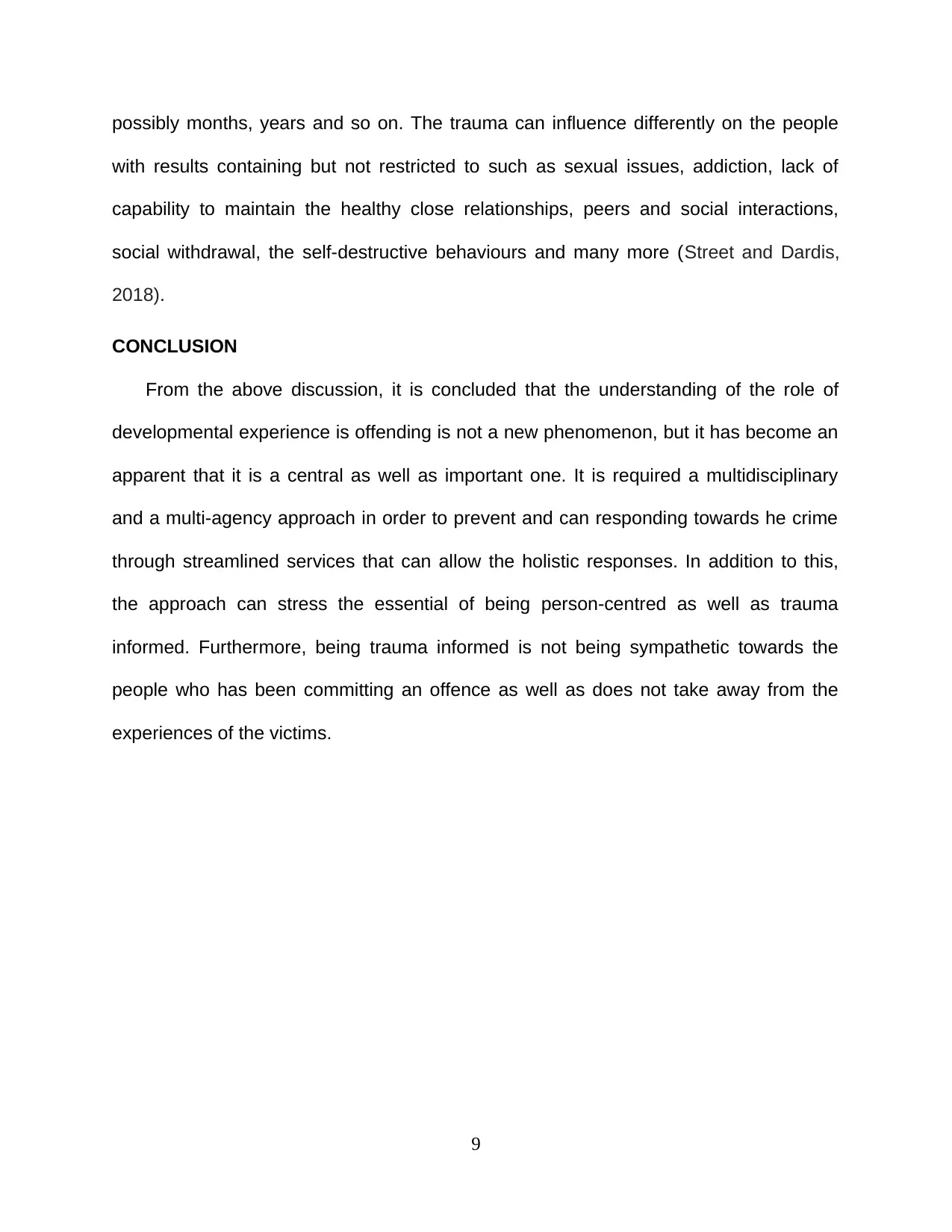
possibly months, years and so on. The trauma can influence differently on the people
with results containing but not restricted to such as sexual issues, addiction, lack of
capability to maintain the healthy close relationships, peers and social interactions,
social withdrawal, the self-destructive behaviours and many more (Street and Dardis,
2018).
CONCLUSION
From the above discussion, it is concluded that the understanding of the role of
developmental experience is offending is not a new phenomenon, but it has become an
apparent that it is a central as well as important one. It is required a multidisciplinary
and a multi-agency approach in order to prevent and can responding towards he crime
through streamlined services that can allow the holistic responses. In addition to this,
the approach can stress the essential of being person-centred as well as trauma
informed. Furthermore, being trauma informed is not being sympathetic towards the
people who has been committing an offence as well as does not take away from the
experiences of the victims.
9
with results containing but not restricted to such as sexual issues, addiction, lack of
capability to maintain the healthy close relationships, peers and social interactions,
social withdrawal, the self-destructive behaviours and many more (Street and Dardis,
2018).
CONCLUSION
From the above discussion, it is concluded that the understanding of the role of
developmental experience is offending is not a new phenomenon, but it has become an
apparent that it is a central as well as important one. It is required a multidisciplinary
and a multi-agency approach in order to prevent and can responding towards he crime
through streamlined services that can allow the holistic responses. In addition to this,
the approach can stress the essential of being person-centred as well as trauma
informed. Furthermore, being trauma informed is not being sympathetic towards the
people who has been committing an offence as well as does not take away from the
experiences of the victims.
9
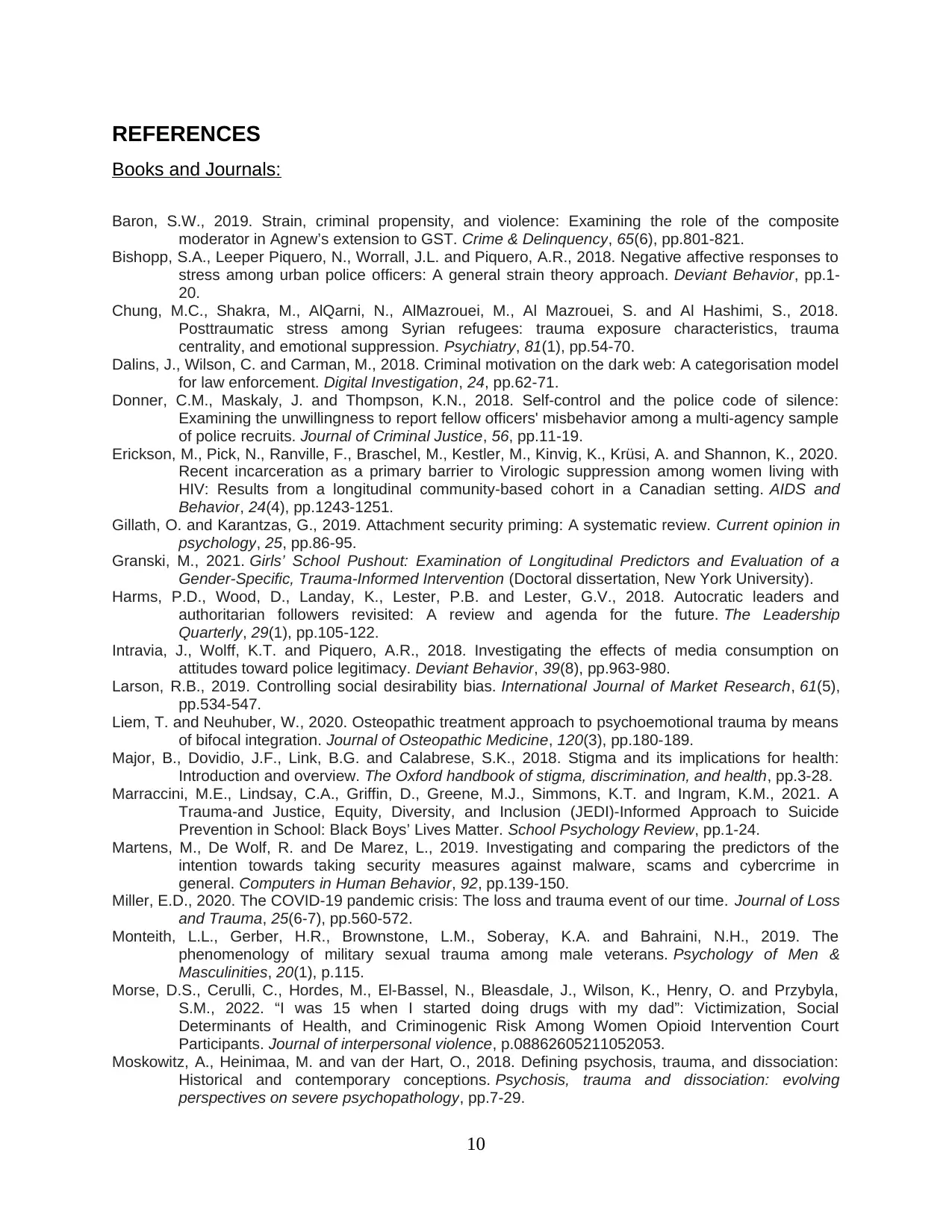
REFERENCES
Books and Journals:
Baron, S.W., 2019. Strain, criminal propensity, and violence: Examining the role of the composite
moderator in Agnew’s extension to GST. Crime & Delinquency, 65(6), pp.801-821.
Bishopp, S.A., Leeper Piquero, N., Worrall, J.L. and Piquero, A.R., 2018. Negative affective responses to
stress among urban police officers: A general strain theory approach. Deviant Behavior, pp.1-
20.
Chung, M.C., Shakra, M., AlQarni, N., AlMazrouei, M., Al Mazrouei, S. and Al Hashimi, S., 2018.
Posttraumatic stress among Syrian refugees: trauma exposure characteristics, trauma
centrality, and emotional suppression. Psychiatry, 81(1), pp.54-70.
Dalins, J., Wilson, C. and Carman, M., 2018. Criminal motivation on the dark web: A categorisation model
for law enforcement. Digital Investigation, 24, pp.62-71.
Donner, C.M., Maskaly, J. and Thompson, K.N., 2018. Self-control and the police code of silence:
Examining the unwillingness to report fellow officers' misbehavior among a multi-agency sample
of police recruits. Journal of Criminal Justice, 56, pp.11-19.
Erickson, M., Pick, N., Ranville, F., Braschel, M., Kestler, M., Kinvig, K., Krüsi, A. and Shannon, K., 2020.
Recent incarceration as a primary barrier to Virologic suppression among women living with
HIV: Results from a longitudinal community-based cohort in a Canadian setting. AIDS and
Behavior, 24(4), pp.1243-1251.
Gillath, O. and Karantzas, G., 2019. Attachment security priming: A systematic review. Current opinion in
psychology, 25, pp.86-95.
Granski, M., 2021. Girls’ School Pushout: Examination of Longitudinal Predictors and Evaluation of a
Gender-Specific, Trauma-Informed Intervention (Doctoral dissertation, New York University).
Harms, P.D., Wood, D., Landay, K., Lester, P.B. and Lester, G.V., 2018. Autocratic leaders and
authoritarian followers revisited: A review and agenda for the future. The Leadership
Quarterly, 29(1), pp.105-122.
Intravia, J., Wolff, K.T. and Piquero, A.R., 2018. Investigating the effects of media consumption on
attitudes toward police legitimacy. Deviant Behavior, 39(8), pp.963-980.
Larson, R.B., 2019. Controlling social desirability bias. International Journal of Market Research, 61(5),
pp.534-547.
Liem, T. and Neuhuber, W., 2020. Osteopathic treatment approach to psychoemotional trauma by means
of bifocal integration. Journal of Osteopathic Medicine, 120(3), pp.180-189.
Major, B., Dovidio, J.F., Link, B.G. and Calabrese, S.K., 2018. Stigma and its implications for health:
Introduction and overview. The Oxford handbook of stigma, discrimination, and health, pp.3-28.
Marraccini, M.E., Lindsay, C.A., Griffin, D., Greene, M.J., Simmons, K.T. and Ingram, K.M., 2021. A
Trauma-and Justice, Equity, Diversity, and Inclusion (JEDI)-Informed Approach to Suicide
Prevention in School: Black Boys’ Lives Matter. School Psychology Review, pp.1-24.
Martens, M., De Wolf, R. and De Marez, L., 2019. Investigating and comparing the predictors of the
intention towards taking security measures against malware, scams and cybercrime in
general. Computers in Human Behavior, 92, pp.139-150.
Miller, E.D., 2020. The COVID-19 pandemic crisis: The loss and trauma event of our time. Journal of Loss
and Trauma, 25(6-7), pp.560-572.
Monteith, L.L., Gerber, H.R., Brownstone, L.M., Soberay, K.A. and Bahraini, N.H., 2019. The
phenomenology of military sexual trauma among male veterans. Psychology of Men &
Masculinities, 20(1), p.115.
Morse, D.S., Cerulli, C., Hordes, M., El-Bassel, N., Bleasdale, J., Wilson, K., Henry, O. and Przybyla,
S.M., 2022. “I was 15 when I started doing drugs with my dad”: Victimization, Social
Determinants of Health, and Criminogenic Risk Among Women Opioid Intervention Court
Participants. Journal of interpersonal violence, p.08862605211052053.
Moskowitz, A., Heinimaa, M. and van der Hart, O., 2018. Defining psychosis, trauma, and dissociation:
Historical and contemporary conceptions. Psychosis, trauma and dissociation: evolving
perspectives on severe psychopathology, pp.7-29.
10
Books and Journals:
Baron, S.W., 2019. Strain, criminal propensity, and violence: Examining the role of the composite
moderator in Agnew’s extension to GST. Crime & Delinquency, 65(6), pp.801-821.
Bishopp, S.A., Leeper Piquero, N., Worrall, J.L. and Piquero, A.R., 2018. Negative affective responses to
stress among urban police officers: A general strain theory approach. Deviant Behavior, pp.1-
20.
Chung, M.C., Shakra, M., AlQarni, N., AlMazrouei, M., Al Mazrouei, S. and Al Hashimi, S., 2018.
Posttraumatic stress among Syrian refugees: trauma exposure characteristics, trauma
centrality, and emotional suppression. Psychiatry, 81(1), pp.54-70.
Dalins, J., Wilson, C. and Carman, M., 2018. Criminal motivation on the dark web: A categorisation model
for law enforcement. Digital Investigation, 24, pp.62-71.
Donner, C.M., Maskaly, J. and Thompson, K.N., 2018. Self-control and the police code of silence:
Examining the unwillingness to report fellow officers' misbehavior among a multi-agency sample
of police recruits. Journal of Criminal Justice, 56, pp.11-19.
Erickson, M., Pick, N., Ranville, F., Braschel, M., Kestler, M., Kinvig, K., Krüsi, A. and Shannon, K., 2020.
Recent incarceration as a primary barrier to Virologic suppression among women living with
HIV: Results from a longitudinal community-based cohort in a Canadian setting. AIDS and
Behavior, 24(4), pp.1243-1251.
Gillath, O. and Karantzas, G., 2019. Attachment security priming: A systematic review. Current opinion in
psychology, 25, pp.86-95.
Granski, M., 2021. Girls’ School Pushout: Examination of Longitudinal Predictors and Evaluation of a
Gender-Specific, Trauma-Informed Intervention (Doctoral dissertation, New York University).
Harms, P.D., Wood, D., Landay, K., Lester, P.B. and Lester, G.V., 2018. Autocratic leaders and
authoritarian followers revisited: A review and agenda for the future. The Leadership
Quarterly, 29(1), pp.105-122.
Intravia, J., Wolff, K.T. and Piquero, A.R., 2018. Investigating the effects of media consumption on
attitudes toward police legitimacy. Deviant Behavior, 39(8), pp.963-980.
Larson, R.B., 2019. Controlling social desirability bias. International Journal of Market Research, 61(5),
pp.534-547.
Liem, T. and Neuhuber, W., 2020. Osteopathic treatment approach to psychoemotional trauma by means
of bifocal integration. Journal of Osteopathic Medicine, 120(3), pp.180-189.
Major, B., Dovidio, J.F., Link, B.G. and Calabrese, S.K., 2018. Stigma and its implications for health:
Introduction and overview. The Oxford handbook of stigma, discrimination, and health, pp.3-28.
Marraccini, M.E., Lindsay, C.A., Griffin, D., Greene, M.J., Simmons, K.T. and Ingram, K.M., 2021. A
Trauma-and Justice, Equity, Diversity, and Inclusion (JEDI)-Informed Approach to Suicide
Prevention in School: Black Boys’ Lives Matter. School Psychology Review, pp.1-24.
Martens, M., De Wolf, R. and De Marez, L., 2019. Investigating and comparing the predictors of the
intention towards taking security measures against malware, scams and cybercrime in
general. Computers in Human Behavior, 92, pp.139-150.
Miller, E.D., 2020. The COVID-19 pandemic crisis: The loss and trauma event of our time. Journal of Loss
and Trauma, 25(6-7), pp.560-572.
Monteith, L.L., Gerber, H.R., Brownstone, L.M., Soberay, K.A. and Bahraini, N.H., 2019. The
phenomenology of military sexual trauma among male veterans. Psychology of Men &
Masculinities, 20(1), p.115.
Morse, D.S., Cerulli, C., Hordes, M., El-Bassel, N., Bleasdale, J., Wilson, K., Henry, O. and Przybyla,
S.M., 2022. “I was 15 when I started doing drugs with my dad”: Victimization, Social
Determinants of Health, and Criminogenic Risk Among Women Opioid Intervention Court
Participants. Journal of interpersonal violence, p.08862605211052053.
Moskowitz, A., Heinimaa, M. and van der Hart, O., 2018. Defining psychosis, trauma, and dissociation:
Historical and contemporary conceptions. Psychosis, trauma and dissociation: evolving
perspectives on severe psychopathology, pp.7-29.
10
⊘ This is a preview!⊘
Do you want full access?
Subscribe today to unlock all pages.

Trusted by 1+ million students worldwide
1 out of 13
Related Documents
Your All-in-One AI-Powered Toolkit for Academic Success.
+13062052269
info@desklib.com
Available 24*7 on WhatsApp / Email
![[object Object]](/_next/static/media/star-bottom.7253800d.svg)
Unlock your academic potential
Copyright © 2020–2025 A2Z Services. All Rights Reserved. Developed and managed by ZUCOL.





